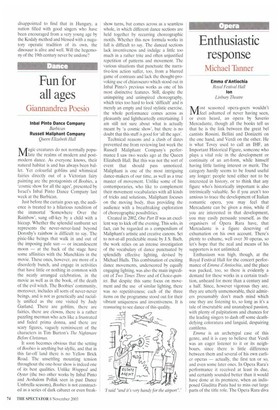Fun for all ages
Giannandre a Poesio
Inbal Pinto Dance Company Barbican Russell Maliphant Company Queen Elizabeth Hall
Magic creatures do not normally populate the realms of modern and postmodern dance. As everyone knows, their natural habitat is and has always been ballet. Yet colourful goblins and whimsical fairies directly out of a Victorian fairy painting are the protagonists of Boobies, a 'cosmic show for all the ages', presented by Israel's Inbal Pinto Dance Company last week at the Barbican.
Just before the curtain goes up, the audience is treated to a hilarious rendition of the immortal 'Somewhere Over the Rainbow', sung off-key by a child with a hiccup. Whether the splendid sunburnt set represents the never-never-land beyond Dorothy's rainbow is difficult to say. The pixie-like beings that walk in and out of the imposing pale sun — or incandescent moon — at the back of the stage have some affinities with the Munchkins in the movie. These ones, however, are more of a disorderly bunch, and engage in activities that have little or nothing in common with the neatly arranged celebration, in the movie as well as in the book, of the death of the evil witch. The Boobies' community, moreover, includes all sorts of never-never beings, and is not as genetically and racially unified as the one visited by Judy Garland. There are goblins, there are fairies, there are clowns, there is a rather puzzling merman who acts like a frustrated and faded prima donna, and there are scary figures, vaguely reminiscent of the characters in Tim Burton's The Nightmare Before Christmas.
It soon becomes obvious that the setting of Boobies is anything but idyllic, and that in this far-off land there is no Yellow Brick Road. The unsettling mounting tension throughout the one-hour show is indeed one of its best qualities. Unlike Wrapped and Oyster (the two other works by Inbal Pinto and Avshalom Pollak seen in past Dance Umbrella seasons), Boobies is not constructed as a series of dark cabaret or even freak
show turns, but comes across as a seamless whole, in which different dance sections are held together by recurring choreographic motifs. Whether this new formula works in full is difficult to say. The danced sections lack inventiveness and indulge a little too much in a rather trite and often unjustified repetition of patterns and movement. The various situations that punctuate the narrative-less action suffer, too, from a blurred game of contrasts and lack the thought-provoking use of chiaroscuro which stood out in Inbal Pinto's previous works as one of his most distinctive features. Still, despite the uninspiring and uninspired choreography, which tries too hard to look 'difficult' and is merely an empty and tired stylistic exercise, the whole performance comes across as pleasantly and lightheartedly entertaining. I am still not sure about what is actually meant by 'a cosmic show', but there is no doubt that this stuff is good for 'all the ages'.
Technical reasons and a clash of dates prevented me from reviewing last week the Russell Maliphant Company's performance I saw two weeks ago at the Queen Elizabeth Hall. But this was not the sort of event that should pass unnoticed. Maliphant is one of the most intriguing dance-makers of our time, as well as a true master of movement. Unlike some of his contemporaries, who like to complement their movement vocabularies with all kinds of tricks and solutions, Maliphant focuses on the moving body, thus providing the audience with a breathtaking exploration of choreographic possibilities.
Created in 2002, One Part II was an excellent way to kick off the evening. This solo, in fact, can be regarded as a compendium of Maliphant's artistic and creative canons. Set to not-at-all predictable music by J. S. Bach, the work relies on an intense investigation of the vocabulary of dance punctuated by splendidly effective lighting, devised by Michael Hulls. This combination of exciting dance movements, underscored by equally engaging lighting, was also the main ingredient of Two Times Three and of Choice-quintet. But despite this same focus on movement and the use of similar lighting, there was no repetitiveness; each of the three items on the programme stood out for their vibrant uniqueness and inventiveness. It is reassuring to see dance of this quality.


































































































 Previous page
Previous page